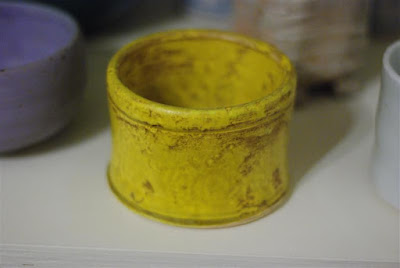
I've decided to dig up more of my old OLD work. Stuff from high school and shortly thereafter. So, tonight's romp through amnesia alley brings us to my first few pots... one thrown and "altered" and the other is my first simple cylinder with my FIRST ever home-made glaze. I still look at this glaze with amazement and wonder what would have happened if my first experiments had met with greater success. I think, by and large, frustration suits me better than success.
When folks ask what it takes to get some of our glazes I never really know what to say. I could hand out formulas till the cows come home and it would be of little to no use. This Grapefruit Green is a perfect case in point.
This glaze was mixed with a paintbrush (didnt know enough to seive a glaze)... remember folks, we're going back over 20 years at this point in my glazing history. Application was by brush. So here is a glaze that was designed back in the 60's by James Chappell (Potters Complete Book Of Clays And Glazes), used LEAD as the main flux. Hey, we had lead in containers in the glaze lab, I wore gloves and mixed according to the book. Probably what everyone does their first time in the glaze lab.
A week later, after firing and while dealing with my frustration over the NOT green color.... and munching down some funky fast food burger.... I started reading the rest of Chappell's book. All of a sudden instead of seeing just the recipes, I started reading about materials and toxicity. I nearly shit myself. I had no idea how dangerous lead could be, both to myself and to any users of this final piece. I came to realize through further reading in the following months (and years) that even with well formulated stable glazes, colorants can affect solubility and safety of glazes.
So here is my first ever glaze, in all of its toxic glory.... loaded with lead and chromium.


5 comments:
Funny - though also a good cautionary tale about safety and making sure that you properly research any new hobby =)
And, for what it's worth, your first attempts look pretty good to me. =)
Too true. In hindsight, I realize that this glaze is what lead me down the path to understanding glaze ingredients, firing problems, toxicology, glazing defects... all sorts of stuff... all from one weird glaze. Just imagine what would have happened if this bloody glaze had worked out okay?!
PS... anne-marie.. I LOVE your blog. My daughter and I read it every couple days! Very fun ideas with soaps.
I'm so glad I read your post today. A couple of days ago, my husband and I came across a box of functional ware his mom (who passed away years ago) left behind. I researched a little and heard from another family member that she got it from an anonymous potter in California many years ago (like maybe 40?)... It's a complete set of handmade dishes... Our plan was to start using the ware as our daily dishes, but the glaze does look kind of "open" and I'm now wondering if that's such a good idea. Suppose I'd better get it tested first!!!
Um. You should send that one to me. I'll keep it from hurting anyone. :) NICE POT!!
You remind me to post photos of a very, very unstable glaze I have. It turns water chartreuse. Tonight, maybe...
Thanks Julie-
That is a piece of ancient history. Wish I had jotted the formula down somewhere. Probably did! It was my first foray into low temp glazes. I mixed it up again about a year later, and it turned a beautiful rich egyptian blue... really nice. So nice in fact, we decided we needed to try it in Raku. Turned metallic GOLD! Go figure.
Post a Comment